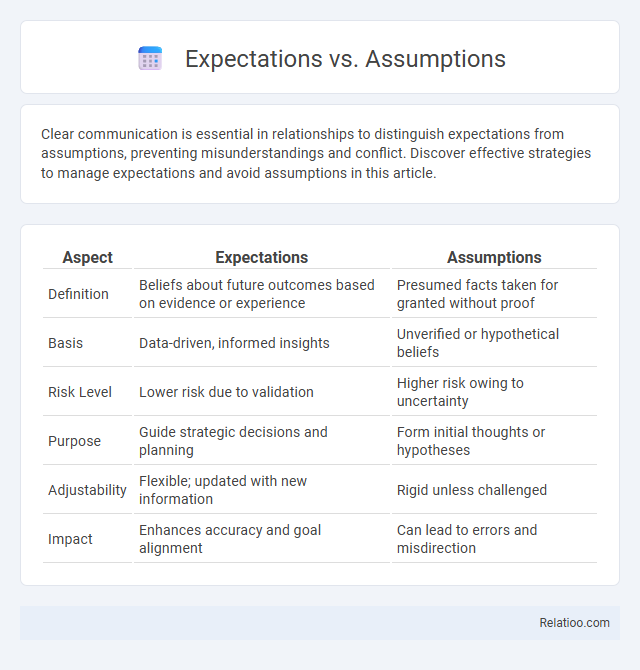Clear communication is essential in relationships to distinguish expectations from assumptions, preventing misunderstandings and conflict. Discover effective strategies to manage expectations and avoid assumptions in this article.
Table of Comparison
| Aspect | Expectations | Assumptions |
|---|---|---|
| Definition | Beliefs about future outcomes based on evidence or experience | Presumed facts taken for granted without proof |
| Basis | Data-driven, informed insights | Unverified or hypothetical beliefs |
| Risk Level | Lower risk due to validation | Higher risk owing to uncertainty |
| Purpose | Guide strategic decisions and planning | Form initial thoughts or hypotheses |
| Adjustability | Flexible; updated with new information | Rigid unless challenged |
| Impact | Enhances accuracy and goal alignment | Can lead to errors and misdirection |
Defining Expectations and Assumptions
Expectations refer to anticipated outcomes based on clear criteria or prior experience, providing a measurable standard for performance or behavior. Assumptions are beliefs accepted as true without proof, often serving as foundational premises that guide decision-making and predictions. Differentiating expectations from assumptions is crucial, as expectations demand evidence or standards, while assumptions fill gaps in knowledge, potentially leading to ambiguity if unexamined.
Key Differences Between Expectations and Assumptions
Expectations are beliefs about how situations or people will behave based on evidence or prior experience, while assumptions are taken-for-granted ideas without verification. Expectations guide decision-making and influence emotional responses, whereas assumptions can lead to misunderstandings if not clarified. The key difference lies in expectations being more conscious and evidence-based, whereas assumptions operate subconsciously and may create ambiguity in communication.
The Psychology Behind Expectations
Expectations shape behavior through cognitive schemas that influence how individuals predict and interpret future events, often leading to confirmation bias when outcomes align or conflict with these mental models. In contrast, assumptions are unconscious beliefs taken for granted without evidence, potentially distorting interpersonal communication and decision-making processes. Ambiguity in psychological contexts generates uncertainty and cognitive dissonance, triggering stress responses as individuals seek clarity to reduce confusion and maintain psychological equilibrium.
How Assumptions Shape Our Perceptions
Assumptions create mental shortcuts that influence how you interpret information, often filling gaps with preconceived notions rather than facts. These mental models shape perceptions by coloring experiences with subjective biases, which can lead to misunderstandings and missed opportunities for clarity. Recognizing assumptions allows for critical evaluation and reduces ambiguity in decision-making processes.
Common Pitfalls of Unchecked Assumptions
Unchecked assumptions often lead to miscommunication and project delays because they bypass clear verification of facts or requirements. You risk making decisions based on incomplete or incorrect information, which creates ambiguity and unmet expectations among team members or stakeholders. Addressing assumptions with explicit dialogue and confirmation prevents costly errors and builds stronger collaboration.
The Impact of Expectations on Relationships
Unrealistic expectations in relationships can lead to disappointment, eroding trust and emotional connection over time. Assumptions about a partner's intentions or feelings without clear communication heighten ambiguity, causing misunderstandings and conflicts. Managing expectations with open dialogue promotes clarity, strengthens bonds, and fosters mutual respect between partners.
Strategies to Clarify Expectations
Clear communication strategies are essential to clarify expectations and prevent misunderstandings caused by assumptions and ambiguity. Establishing specific, measurable goals with transparent timelines fosters alignment between stakeholders, reducing the risk of misinterpretation. Regular feedback loops and open dialogue encourage continuous clarification, ensuring all parties share a consistent understanding of project objectives.
Overcoming the Risks of Assumptions
Overcoming the risks of assumptions requires clearly defining expectations through transparent communication and validating information before acting. Assumptions often lead to misunderstandings and project failures when ambiguous details remain unclarified. Implementing structured feedback loops and continuous verification helps mitigate ambiguity and align team objectives effectively.
Building Better Communication Through Transparency
Clear communication relies on distinguishing expectations, assumptions, and ambiguity to reduce misunderstandings and foster transparency. Explicitly stating expectations prevents conflicts caused by unspoken assumptions, while addressing ambiguity ensures all parties share a common understanding of goals and responsibilities. Emphasizing transparency in dialogue builds trust and creates a collaborative environment where clarity drives better decision-making and stronger relationships.
Cultivating Mindfulness: Managing Expectations and Avoiding Assumptions
Cultivating mindfulness helps you manage expectations by fostering awareness of your thoughts and feelings without judgment, reducing the risk of unmet hopes. Avoiding assumptions involves observing situations clearly, preventing misunderstandings caused by preconceived notions. Embracing ambiguity allows you to stay open to multiple possibilities, promoting flexible thinking and emotional resilience.

Infographic: Expectations vs Assumptions
 relatioo.com
relatioo.com